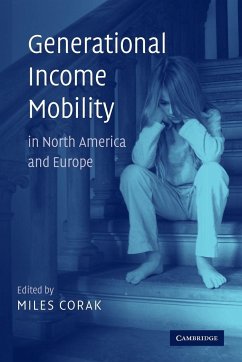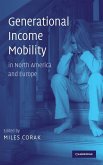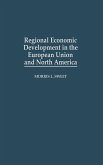Generational Income Mobility in North America and Europe
Herausgeber: Corak, Miles
Generational Income Mobility in North America and Europe
Herausgeber: Corak, Miles
- Broschiertes Buch
- Merkliste
- Auf die Merkliste
- Bewerten Bewerten
- Teilen
- Produkt teilen
- Produkterinnerung
- Produkterinnerung
2004 analysis contrasting economic mobility in American/British economies with corporate state models of continental Europe.
Andere Kunden interessierten sich auch für
![Generational Income Mobility in North America and Europe Generational Income Mobility in North America and Europe]() Miles Corak (ed.)Generational Income Mobility in North America and Europe114,99 €
Miles Corak (ed.)Generational Income Mobility in North America and Europe114,99 €![Banking in North America Banking in North America]() J. Haar / K. Dandapani (eds.)Banking in North America171,99 €
J. Haar / K. Dandapani (eds.)Banking in North America171,99 €![A New North America A New North America]() A New North America80,99 €
A New North America80,99 €![Success Factors of Startup Companies. An Empirical Analysis of E-Business Startups in North America Success Factors of Startup Companies. An Empirical Analysis of E-Business Startups in North America]() Nikras AghaSuccess Factors of Startup Companies. An Empirical Analysis of E-Business Startups in North America47,95 €
Nikras AghaSuccess Factors of Startup Companies. An Empirical Analysis of E-Business Startups in North America47,95 €![Regional Economic Development in the European Union and North America Regional Economic Development in the European Union and North America]() Morris L. SweetRegional Economic Development in the European Union and North America101,99 €
Morris L. SweetRegional Economic Development in the European Union and North America101,99 €![A New North America A New North America]() A New North America40,99 €
A New North America40,99 €![Worker Mobility and Urban Policy in Latin America Worker Mobility and Urban Policy in Latin America]() David López-GarcíaWorker Mobility and Urban Policy in Latin America63,99 €
David López-GarcíaWorker Mobility and Urban Policy in Latin America63,99 €-
-
-
2004 analysis contrasting economic mobility in American/British economies with corporate state models of continental Europe.
Hinweis: Dieser Artikel kann nur an eine deutsche Lieferadresse ausgeliefert werden.
Hinweis: Dieser Artikel kann nur an eine deutsche Lieferadresse ausgeliefert werden.
Produktdetails
- Produktdetails
- Verlag: Cambridge University Press
- Seitenzahl: 340
- Erscheinungstermin: 26. Mai 2011
- Englisch
- Abmessung: 229mm x 152mm x 18mm
- Gewicht: 494g
- ISBN-13: 9781107402812
- ISBN-10: 1107402816
- Artikelnr.: 33625924
- Herstellerkennzeichnung
- Libri GmbH
- Europaallee 1
- 36244 Bad Hersfeld
- gpsr@libri.de
- Verlag: Cambridge University Press
- Seitenzahl: 340
- Erscheinungstermin: 26. Mai 2011
- Englisch
- Abmessung: 229mm x 152mm x 18mm
- Gewicht: 494g
- ISBN-13: 9781107402812
- ISBN-10: 1107402816
- Artikelnr.: 33625924
- Herstellerkennzeichnung
- Libri GmbH
- Europaallee 1
- 36244 Bad Hersfeld
- gpsr@libri.de
1. Introduction M. Corak; 2. A model of intergenerational mobility
variation over time and place G. Solon; 3. Equal opportunity and
intergenerational mobility: going beyond intergenerational income
transition matrices John E. Roemer; 4. Intergenerational mobility for whom?
The experience of high and low earning sons in international perspective N.
Grawe; 5. Trends in the intergenerational economic mobility of sons and
daughters in the United States S. Mayer and L. Lopoo; 6. Changes in
intergenerational mobility in Britain J. Blanden, A. Goodman, P. Gregg and
S. Machin; 7. Intergenerational mobility in Britain: new evidence from the
British household panel survey J. Ermisch and M. Francesconi; 8. Nonlinear
patterns of intergenerational mobility in Germany and the United States K.
Couch and D. Lillard; 9. Family structure and labour market success A.
Björklund, E. Österbacka, M. Jäntti, O. Raaum and T. Eriksson; 10. New
evidence on the intergenerational correlations in welfare participation M.
Page; 11. Intergenerational influences on the receipt of unemployment
insurance in Canada and Sweden M. Corak, B. Gustafsson and T. Österberg;
12. Unequal opportunities and the mechanisms of social inheritance G.
Esping-Andersen; Conclusion.
variation over time and place G. Solon; 3. Equal opportunity and
intergenerational mobility: going beyond intergenerational income
transition matrices John E. Roemer; 4. Intergenerational mobility for whom?
The experience of high and low earning sons in international perspective N.
Grawe; 5. Trends in the intergenerational economic mobility of sons and
daughters in the United States S. Mayer and L. Lopoo; 6. Changes in
intergenerational mobility in Britain J. Blanden, A. Goodman, P. Gregg and
S. Machin; 7. Intergenerational mobility in Britain: new evidence from the
British household panel survey J. Ermisch and M. Francesconi; 8. Nonlinear
patterns of intergenerational mobility in Germany and the United States K.
Couch and D. Lillard; 9. Family structure and labour market success A.
Björklund, E. Österbacka, M. Jäntti, O. Raaum and T. Eriksson; 10. New
evidence on the intergenerational correlations in welfare participation M.
Page; 11. Intergenerational influences on the receipt of unemployment
insurance in Canada and Sweden M. Corak, B. Gustafsson and T. Österberg;
12. Unequal opportunities and the mechanisms of social inheritance G.
Esping-Andersen; Conclusion.
1. Introduction M. Corak; 2. A model of intergenerational mobility
variation over time and place G. Solon; 3. Equal opportunity and
intergenerational mobility: going beyond intergenerational income
transition matrices John E. Roemer; 4. Intergenerational mobility for whom?
The experience of high and low earning sons in international perspective N.
Grawe; 5. Trends in the intergenerational economic mobility of sons and
daughters in the United States S. Mayer and L. Lopoo; 6. Changes in
intergenerational mobility in Britain J. Blanden, A. Goodman, P. Gregg and
S. Machin; 7. Intergenerational mobility in Britain: new evidence from the
British household panel survey J. Ermisch and M. Francesconi; 8. Nonlinear
patterns of intergenerational mobility in Germany and the United States K.
Couch and D. Lillard; 9. Family structure and labour market success A.
Björklund, E. Österbacka, M. Jäntti, O. Raaum and T. Eriksson; 10. New
evidence on the intergenerational correlations in welfare participation M.
Page; 11. Intergenerational influences on the receipt of unemployment
insurance in Canada and Sweden M. Corak, B. Gustafsson and T. Österberg;
12. Unequal opportunities and the mechanisms of social inheritance G.
Esping-Andersen; Conclusion.
variation over time and place G. Solon; 3. Equal opportunity and
intergenerational mobility: going beyond intergenerational income
transition matrices John E. Roemer; 4. Intergenerational mobility for whom?
The experience of high and low earning sons in international perspective N.
Grawe; 5. Trends in the intergenerational economic mobility of sons and
daughters in the United States S. Mayer and L. Lopoo; 6. Changes in
intergenerational mobility in Britain J. Blanden, A. Goodman, P. Gregg and
S. Machin; 7. Intergenerational mobility in Britain: new evidence from the
British household panel survey J. Ermisch and M. Francesconi; 8. Nonlinear
patterns of intergenerational mobility in Germany and the United States K.
Couch and D. Lillard; 9. Family structure and labour market success A.
Björklund, E. Österbacka, M. Jäntti, O. Raaum and T. Eriksson; 10. New
evidence on the intergenerational correlations in welfare participation M.
Page; 11. Intergenerational influences on the receipt of unemployment
insurance in Canada and Sweden M. Corak, B. Gustafsson and T. Österberg;
12. Unequal opportunities and the mechanisms of social inheritance G.
Esping-Andersen; Conclusion.








